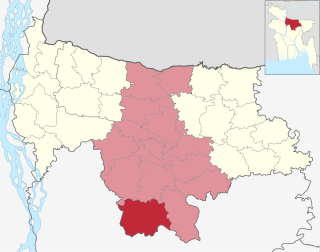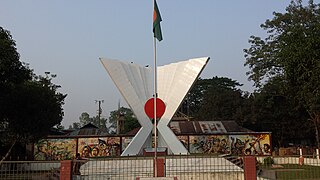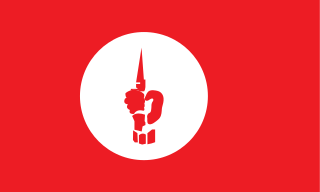Munshi Abdur Rouf BS was a Lance Nayek in the 11 Wing of East Pakistan Rifles during the Bangladesh Liberation War. He enlisted in the East Pakistan Rifles on 8 May 1963, and was attached with a regular infantry unit during the War of Liberation. Rouf died on 8 April 1971 at Burighat in Chittagong Hill Tracts after causing extensive damage to the Pakistani Army with his machine gun and forcing them to retreat. He was buried at Naniarchor Upazila in Rangamati District.
Taramon Bibi Bir Protik was one of the two female freedom fighters in Bangladesh obtaining the Bir Protik award. She engaged in direct combat during the liberation war of Bangladesh in 1971 as a member of the Mukti Bahini which was a guerrilla force that fought against the Pakistan military.
Muhammad Ataul Gani Osmani, was a Bengali military leader. Osmani's career spanned five decades, beginning with service in the British Indian Army in 1939. He fought in the Burma Campaign during World War II. After the partition of India in 1947, he joined the Pakistan Army and served in the East Bengal Regiment, retiring as a colonel in 1967. Osmani joined the Provisional Government of Bangladesh in 1971 as the commander-in-chief of the nascent Bangladesh Forces. Regarded as the founder of the Bangladesh Armed Forces, Osmani retired as a four-star general from the Bangladesh Army in 1972.

Armed Forces Day is observed in Bangladesh on 21 November. This signifies the day in 1971, when the members of the Bangladesh army, navy and air force were officially united and launched joint operations against the Pakistan occupation forces. On 16 December 1971, the Pakistani Army of 93,000 surrendered to the allied force of Bangladesh army, ending the Liberation War of Bangladesh.
The Swadhin Bangla Biplobi Parishad was an armed underground student political group secretly organized in 1961 by Serajul Alam Khan, a key founder of Bangladesh, that worked to wage an armed secessionist struggle against Pakistani rule and achieve the independence of East Pakistan as "Bangladesh".
The Bangladesh Liberation War started on 26 March 1971 and ended on 16 December 1971. Some of the major events of the war are listed in the timeline below.

Bhaluka is an upazila of the Mymensingh District located in Bangladesh. It is one of the oldest small business hubs in the area.
The Mujib Bahini, also known as Bangladesh Liberation Force (BLF), was an armed force formed during the Bangladesh Liberation War to fight against Pakistan in 1971. The force was mainly composed of activists drawn from the Awami League and its student front, the Chhatra League. At its height, it had reportedly 10,000 members. It was organised with the active assistance of Major General Sujan Singh Uban of the Indian Army. Serajul Alam Khan and Sheikh Fazlul Haque Mani, Tofael Ahmed and Abdur Razzaq were the organizers of this force.
Kader Bahini was an independent militia created during the Bangladesh Liberation War of 1971, the other being Mukti Bahini. It was named after its leader, Kader Siddique.
The Indian Army had no standby force ready in 1971 with the specific task of attacking East Pakistan, one of the many reasons why India did not immediately intervene after Pakistan launched Operation Searchlight in March 1971. Indian Army's Eastern Command was tasked with defending the northern and eastern borders and fighting the insurgencies in Nagaland, Mizoram and Naxalites in West Bengal at that time.

The Battle of Kamalpur, launched against the Pakistan Army, is one of the most significant military engagements fought by the Guerrilla armed resistance group, The Mukti Bahini in 1971 during it's war of independence from Pakistan. The Pakistani Army set up a military camp at Kamalpur which was attacked by 1st East Bengal Regiment of Z Force several times. The first attack was made on June 12, and a second attack was made on July 31, 1971, also another attack at 22 October 1971, in total there were 18 battles in Kamalpur, Syed Sadruzzaman Helal led 14 battles against the Pakistani Army which heavily weakened the Pakistani forces present in Kamalpur. India joined the war at Late November, they sent their military formations to take Kamalpur, but it was harder for the Indian Army than expected, they made more than 3 unsuccessful attempts to take Kamalpur, the Indian Army's moral was deteriorating, and Casualties were heavily increasing but they knew the Pakistani forces had no artillery, only 2 mortars left, finally, on December 4, the Pakistani Army was overrun and withdrawn and fell back to their headquarters at Jamalpur after an attack by the Bangladeshi Forces and the Indian Army. The Battle of Kamalpur was the deadliest major military engagement in the Bangladeshi War of Liberation, The Mukti Bahini lost 194 soldiers in the battle The Indian Army lost more than 46 soldiers in the battle and a 113 wounded Meanwhile, The Pakistani Army had the most casualties, The Pakistani Army lost 497 soldiers in the battle and around 162 and 220 soldiers captured In the aftermath of the battle, Pakistani troops were defeated and Jamalpur became liberated from Pakistani occupation.

Prior to Bangladesh Liberation War in 1971, India had no plans for large scale military action in East Pakistan. Since the Sino-Indian War of 1962, the primary objective of the Indian Army Eastern Command was the defence of the Indian northern and eastern borders, defending the "Shiliguri Corridor", and on combating insurgencies raging in Mizoram, Nagaland, Manipur and the Naxalites in West Bengal.

Ahmed Imtiaz Bulbul was a Bangladeshi lyricist, composer and music director, active since the late 1970s. He was a freedom fighter who joined the Bangladesh Liberation War at the age of 15. He won Ekushey Padak and Bangladesh National Film Award for Best Music Director twice for the films Premer Taj Mahal (2001) and Hajar Bachhor Dhore (2005).

The Mukti Bahini, also known as the Bangladesh Forces, was the guerrilla resistance movement consisting of the Bangladeshi military, paramilitary and civilians during the Bangladesh Liberation War that transformed East Pakistan into Bangladesh in 1971. They were initially called the Mukti Fauj.
Z Force, also known as Tura Brigade, was the first military brigade of Bangladesh Forces formed during the Liberation War of Bangladesh in 1971 under Major Ziaur Rahman along with the consent of the revolutionary government of Bangladesh in exile. The brigade was formed with the 1st, 3rd and 8th Battalion of East Bengal Regiment on 7 July 1971. It is the first ever complete brigade formed during the Liberation War of Bangladesh in 1971.

Muktijoddha Sangsad a non-political welfare association of the combatants during the Bangladesh Liberation War formed on 13 February 1972. The organisation has a football club, Muktijoddha Sangsad KC, named after itself.
The NAP-Communist Party-Students Union Special Guerrilla Forces was an armed force active in the Bangladesh Liberation War. It was organized jointly by the National Awami Party (Muzaffar) (NAP), Communist Party of Bangladesh and the East Pakistan Students Union. Its commander was Mohammad Farhad, with Pankaj Bhattacharya serving as deputy commander. Per the account of Moni Singh, the NAP-Communist Party-Students Union Special Guerrilla Forces had some 5,000 fighters at its peak.
The Battle of Shiromoni was fought during the Bangladesh Liberation War and the Indo-Pakistani War of 1971 between the Pakistani Army and the joint forces of the Bangladesh and Indian Army. This was one of the last battles of the Bangladesh Liberation War which continued until 17 December 1971, even though the commander of all Pakistani Forces in Bangladesh had already surrendered on 16 December 1971.
Golam Helal Morshed Khan is a retired Major General of the Bangladesh Army and veteran of the Bangladesh Liberation War. He was awarded Bir Bikrom, third highest gallantry award, for his actions in the war. He participated in the 1996 Bangladeshi coup d'état attempt.
Akbar Bahini was a volunteer force during the Bangladesh Liberation War. Akbar Hossain Miah was the Chairman of Srikul Union in Sreepur PS of Magura District. Immediately after the outbreak of war, Akbar Hossain devoted himself in organising a group of fighters. The majority of the members of Akbar Bahini were extracted from amongst the locals of Sreepur area, but, also included members of the East Pakistan Rifles. Akbar Hossain Miah, formed a group of freedom fighters 'Akbar Bahini'. Akbar Hossain was the commander, and Mollah Nabuwat Ali was its deputy commander.






